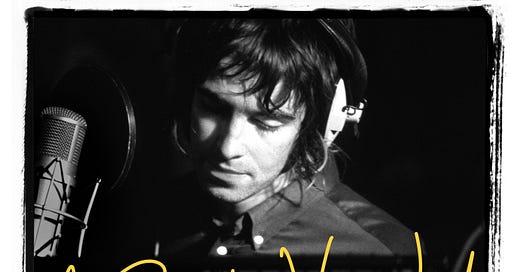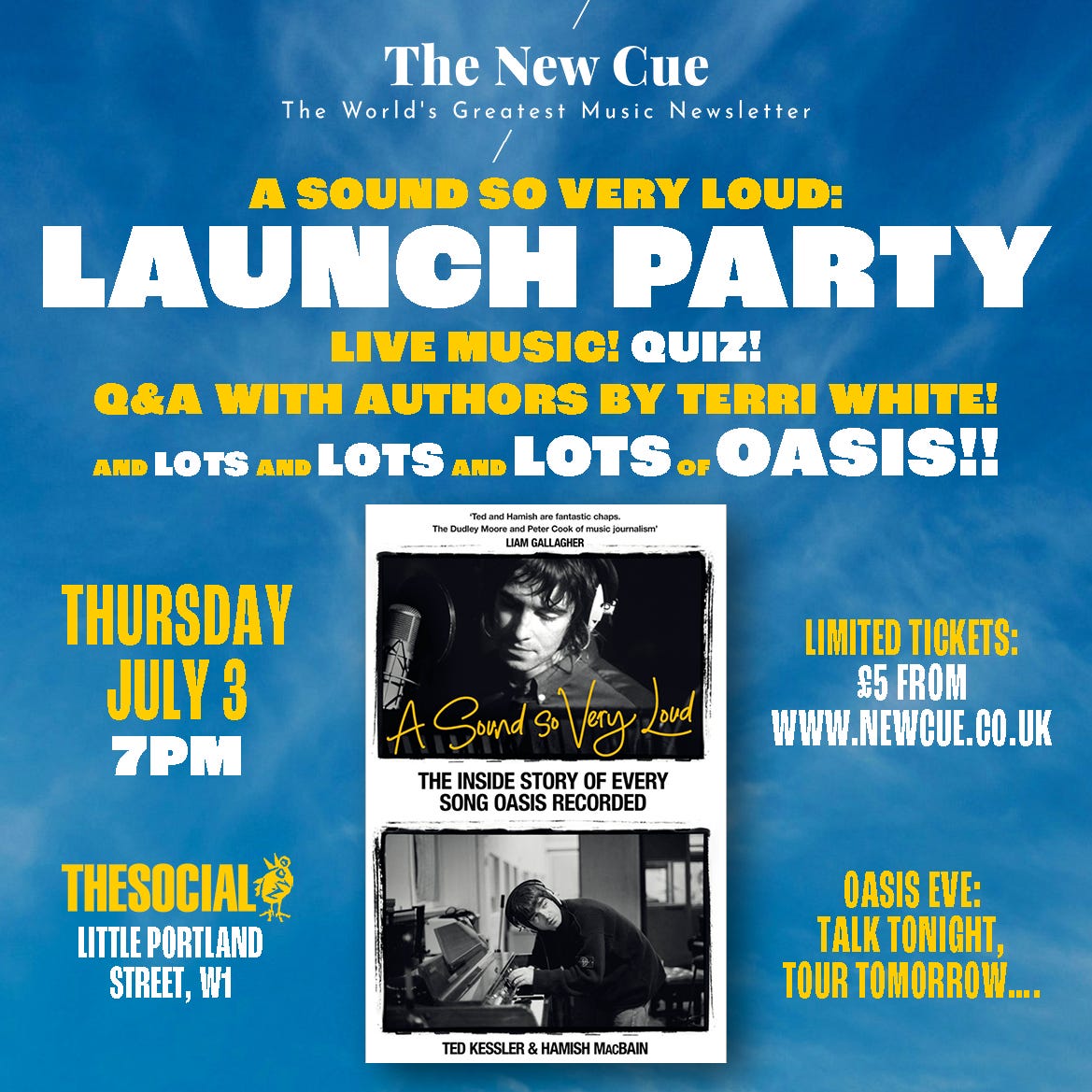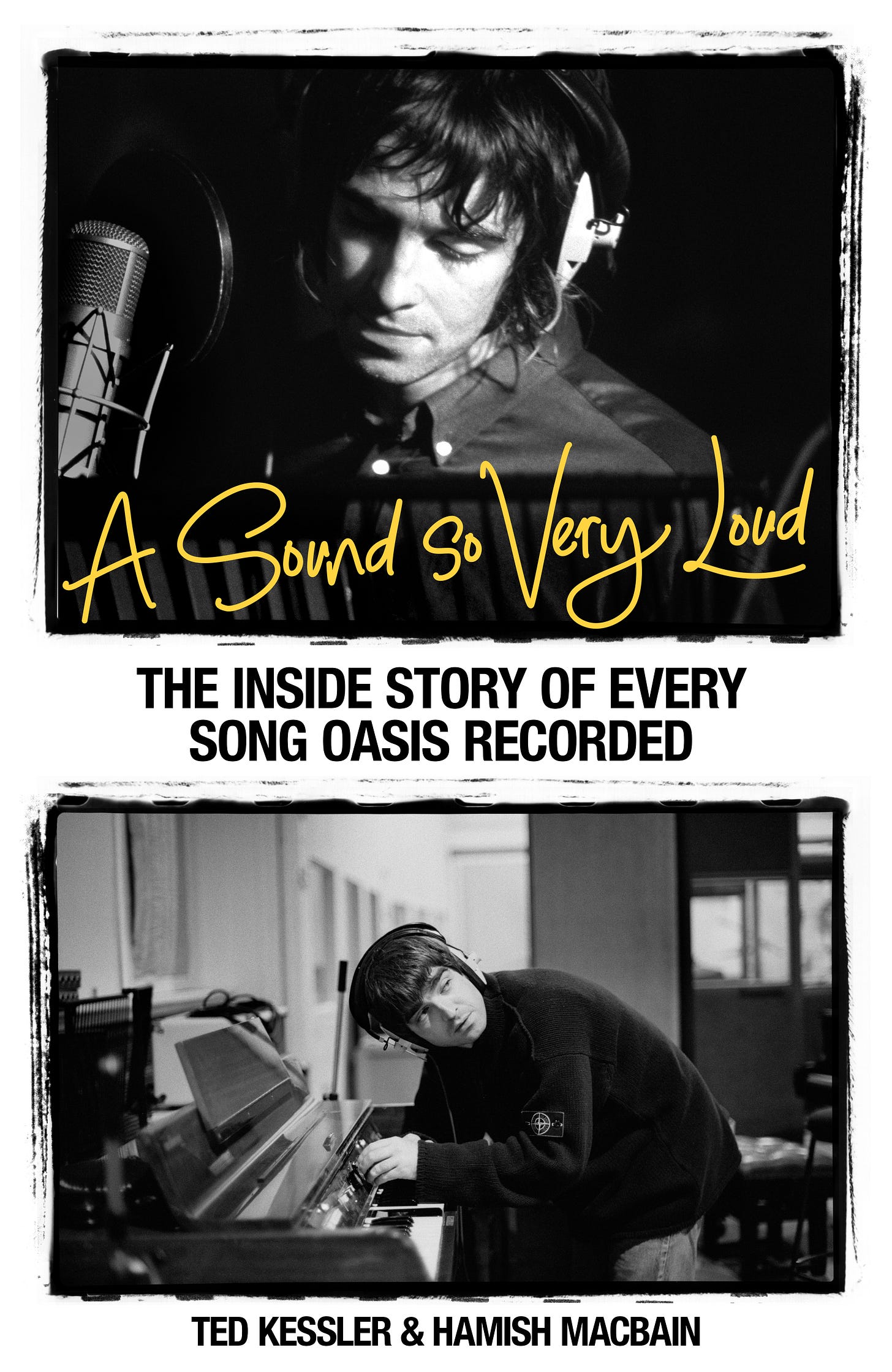The New Cue #503 June 25: Oasis, Oasis and Oasis: exclusive book extracts and discount code, plus event news.
"I never get a phone call from Liam unless it’s a problem."
Good morning,
It’s Wednesday, June 25. In nine days, Oasis play Cardiff’s Millennium Stadium, their first concert since August 2009. The day before, on July 3rd, coincidentally I, Ted, have a book published alongside my co-author Hamish MacBain called A Sound So Very Loud: The Inside Story of Every Song Oasis Recorded.
I’m not a guy who likes to blow my own trumpet (I am actually that guy), but it’s already a critical smash. Five stars in MOJO magazine, the music journal of record (“of the slew of Oasis books…this is the one to reach for”), five stars in The Telegraph (“the best Oasis book…the pair have written something special: a book of wit and verve”), five stars in Record Collector (“essential”), etc. Maybe there’ll be some more reviews to clip this weekend, let’s see.
Our publisher, Pan MacMillan, have generously supplied a code for New Cue readers that delivers a whopping 25% discount on the full price of A Sound So Very Loud when applied at checkout online only at Waterstones, here. Just enter the code when prompted: Loud25. This code is only valid for seven days, expiring on July 3rd. You’re welcome.
Below, we’ll run a couple of extracts from the book, choosing two Oasis B-sides, Stay Young and Half The World Away. But if you prefer to have your books read to you live by the authors in an air-conditioned nightclub with an amazing sound system, then you’re in luck. Because on publication day, Thursday July 3, Hamish and I will be reading some of the book, as well as being interviewed by the legend Terri White, welcoming a very special musical guest, and singing and playing along to lots of Oasis at supersonic volume in the basement of The Social, London W1. There are still a dozen or so £5 tickets left and we’d absolutely love you to join us. It’s Oasis eve. The best night of the decade. Pick your tickets up here.
Book extracts after the jump. Hope you enjoy them. We’ll see you again on Friday.
Ted and Niall
Book Extracts: A Sound So Very Loud
#1: ‘Half The World Away’
B-side of ‘Whatever’, 1994
Like Noel and Liam Gallagher, Caroline Aherne was the product of Irish immigrants who eventually settled on an estate in south Manchester in the 1960s. They had more than just their geographic and ancestral backgrounds in common too. Both the Gallaghers and Aherne were part of a new arts and media class that emerged in the 1990s, a generation of state-educated British artists, musicians, writers, models and actors who came of age in Thatcher’s Britain, but, unlike their forebears, were not interested in protest or political moralizing. Instead, their ideology was to make the most of their talents and to reach as many people as possible without compromising the basic proposition.
For Aherne, that meant her work as a once-in-a-generation writer and performer of comedy characters and situations. She forged her reputation principally as Mrs Merton, a slyly prim Mancunian pensioner whose fake BBC chat show featured her interviewing and skewering real celebrities with deliciously dead-pan relish. After that success, she and her writing partner Craig Cash (another Mancunian) could sketch their own TV future.
What they chose to make was The Royle Family, a situation comedy set entirely in the front room, kitchen and occasionally toilet of a (not often) working-class family in a terraced house somewhere in Manchester. The Royle Family broke every TV comedy convention. Most of the ‘action’ centred on the family members, neighbours and associates sitting on a sofa half-watching television and chatting, eating their dinners on trays and smoking. No laugh track, no backstory; everything took place in real time. There was quite a lot of silence. If it didn’t take place in that room – and very little physically happened – it didn’t exist. It was all about the characters, the kind of dole class Northern family that was entirely absent from all popular culture but no doubt clearly recognizable to the members of Oasis.
‘I instantly fell in love with it,’ Noel told Matt Morgan for his podcast. ‘My dad was a version of Jim Royle, which is like, “Everything on the telly is shit”, and me mam was like, “Jesus Christ, shut up!” That was our house. I fell in love with the pregnant pauses more than anything.’
The first episode took place at 10 p.m. on 14 September 1998, on BBC One, and centred on the story of Jim Royle, the irritable patriarch, buying a pair of knock-off jeans from family friend Twiggy, as well as consuming a bag of pork scratchings he makes his son Anthony pick up from the shop on a three-pack cigarette dash. The subplot involved the arrival of a phone bill and the hunt for the perpetrator of a surprising phone call to Aberdeen. Future son-in- law Dave (played by Craig Cash) describes his dinner of corn beef hash and later farts, twice. Daughter Denise – Aherne’s character– browses the Y-fronts in a clothing catalogue. That’s it. As the credits roll to introduce the show to a grainy time-lapse video of the sofa and its occupants, the only piece of music ever featured floods the screen with emotion: ‘Half the World Away’, Noel Gallagher at his most plaintive, a melancholic masterpiece of yearning and frustration about one’s location-cursed circumstances that he’d inexplicably buried on a B-side four years earlier. The song is repeated over the black-screen end credits to often devastating effect.
Sometime earlier, Mark Coyle had introduced the Oasis tour bus to the wonder of Burt Bacharach and Hal David’s ‘This Guy’s in Love with You’, the 1968 heartbreaker hit they’d provided for Herb Alpert to sing. Upon hearing it, Tony McCarroll claims he suggested to Noel that the shuffling beat (one of his two specialities) could be lifted for a new Oasis song. Noel thought it deserved more than that and sketched out ‘Half the World Away’ in its image. ‘It’s exactly the same,’ he admitted later. ‘I’m surprised he [Bacharach] hasn’t sued me.’
That’s a harsh self-assessment. The electric piano riff is very similar, as is that shuffling beat, but the vocal melody framing the choruses is noticeably different, as are the sentiments. Hal David is among the greatest lyricists of all time and ‘This Guy’s in Love’ is another lyrical miracle about unrequited love in the same lineage of his ‘Walk On By’ or ‘I Say a Little Prayer’, but would David have been able to capture the desperation to escape the environment you are a product of as poignantly as Noel does on ‘Half the World Away’? Arguably not. Noel wasn’t signed to a recording contract until he was twenty-seven and would have felt the darkening of one’s horizons more keenly than most superstar songwriters. ‘Half the World Away’ is Noel’s wheelhouse, occupying a similar desperation to that frequently mapped by another late-developing Mancunian of Irish parentage, Morrissey. It also reveals a mental vulnerability – ‘I can feel the warning signs, running around my mind’ – that Noel wasn’t otherwise describing in his 1994 songbook.
‘Half the World Away’ was recorded on tour in October ’94 during the quick-fire, ill-tempered Congress House sessions in Austin, Texas, that also delivered ‘Talk Tonight’, ‘a second country and western song’ as Noel described it. Frustrated by McCarroll’s inability to play ‘(It’s Good) To Be Free’, Noel banished the drummer from the studio during recording and put down the beat to ‘Half the World Away’ himself. Bonehead provides the gentle electric piano.
Over the years, as the show that brought the song to the nation’s attention grew across three seasons and five specials into one of Britain’s most beloved comedies, even Noel came to think of ‘Half the World Away’ as the Royle Family song. He was, however, initially sceptical about its use.
‘I’d known Craig Cash for a while and he explained what The Royle Family was about,’ Noel said, when discussing the original pitch for a theme. ‘I was thinking, Well, “Married with Children” is perfect. “Half the World Away” didn’t make any sense to me. It’s all about desperately trying to leave the situation you’re in, dreaming of being somewhere else, leaving the house, leaving the city you’re in. When you put it together, it’s quite tragic. They’re all tied to each other in that little room.’
Four days after Aherne died of cancer at just fifty-two on 2 July 2016, Noel appeared with his High Flying Birds in Nashville’s Ryman Auditorium. That night, he dedicated ‘Half the World Away’ to ‘a friend of mine . . . her name was Caroline, and she was a very, very, very funny woman. She used the next song on a very, very, very brilliant sitcom in England called The Royle Family.’ He’s dedicated it to her again at subsequent performances, the song becoming a staple of his post-Oasis live show. It even found its way onto Liam Gallagher’s setlist during his 2024 Definitely Maybe tour, with Liam dedicating it to ‘Noel fucking Gallagher’ at Reading Festival. In 2015, a soft-focus cover version by Norwegian singer-songwriter AURORA soundtracked the John Lewis TV Christmas advert, reimbursing Noel, as he later joked, for some of the money he’d spent in the department store over previous Christmases.
Where would ‘Half the World Away’ sit in Noel Gallagher’s canon had Caroline Aherne and Craig Cash not chosen it as the theme to The Royle Family? Would it have connected so forcibly with so many otherwise? It made its way onto the multimillion-selling Masterplan compilation, so perhaps it would have still been described by Noel as his favourite B-side, as he revealed in conversation at a Salford Lads’ Club benefit in 2019. Like ‘Don’t Look Back in Anger’, though, it’s an Oasis song that had to flee the nest to truly find its place in the universe, and for that it owes its life to The Royle Family. TK
#2: Stay Young
B-Side of ‘D’You Know What I Mean?’, 1997
Imagine you’re the biggest band in the world and you haven’t released any new music for over a year. Your last album is still selling in astronomical quantities, and you cannot leave your house without journalists or fans pestering you about what is happening next. Finally: you are ready. You sequence the songs you’ve recorded into an album and choose one that will act as a statement of intent, an indicator of what you want to say, as the first single.
There are a few songs left over, one of which is a poppy, throwaway, almost bubblegum song. It’s great, but it doesn’t speak to where you’re at. So you hide it away on a B-side. And then the biggest radio station in the country decides that they like the poppy, throwaway, almost bubblegum song just as much as the big, dark statement-of-intent song and start playing it on heavy rotation, effectively upgrading your B-side to an A-side.
In 1997, the influence of BBC Radio 1 in the UK was such that it was pretty much impossible to have a hit single without it. Making it onto the A-list meant that a song would be guaranteed at least twenty-five plays to a listenership of about 15 million people: a quarter of the country. Most artists would tailor their singles to give them the best chance of being selected for this list. A short intro over which the DJ could talk. Vocals coming in quickly. Big, catchy chorus. Three and a half minutes long.
Oasis, of course, did not have to adhere to these rules at this stage. The public’s appetite for their new material was such that they could supply an eight-minute song whose vocals did not arrive until over a minute in and the radio stations would have to play it. What they didn’t bank on was that the radio stations would clock that, tucked away on its B-side, was a song that could not have been any more radio-friendly. So, in the spring of 1997, the bright, light, happy vibes of ‘Stay Young’ blasted out of car stereos as often as ‘D’You Know What I Mean?’.
Within a week of its release, Noel Gallagher was making no secret of his feelings about the song. ‘As soon as we’d finished it,’ he said to Ted, ‘I just kept seeing the word “Britpop” everywhere. It’s a bit too jolly, y’know. Nice sentiments, though: “Stay young and invincible . . .”’
By 1997, Britpop was indeed as dirty a word as you could imagine. Blur had just released their self-titled fifth album: a record that dispensed with all the bouncy whimsy that had made them stars and replaced it with discordant, alternative America-influenced guitars and a dark lead single about heroin. Pulp had retreated to the studio to make their paranoid, druggy, end-of-the party album This Is Hardcore. Supergrass were refusing to play ‘Alright’ and putting out an album called In It for the Money. At the other end of the spectrum, former boyband member Robbie Williams had just released his debut single: an ersatz Oasis song called ‘Old Before I Die’. Television heartthrobs – see Sean Maguire’s ‘Today’s the Day’ or Ant & Dec’s ‘Shout’ – were doing similar. Even the likes of Bryan Adams and Bon Jovi were producing music that was unashamedly, overtly Brit-guitar-influenced – with the specific purpose of getting back on the radio. Britpop, a smart/ subversive reaction to the grandstanding misery of grunge, had now been fully co-opted by the mainstream. Nobody with any credibility whatsoever wanted to be associated with it.
‘Stay Young’ was written before this period and became one of the first songs to be recorded during the Be Here Now sessions at Abbey Road, immediately after Knebworth (and a chaotic US tour that Noel walked off) at the end of 1996. ‘When you start doing an album,’ said Noel, ‘you usually start with the ones you like least, just to get into it really.’ By the time it came to sequencing the record, ‘Magic Pie’ was favoured over ‘Stay Young’, and it was discarded from the tracklist.
‘I don’t like it,’ Noel would reiterate. ‘I don’t like the guitar solo on it. I don’t like the sound of it either.’
When it came time to tour Be Here Now, though – with the help of a set that saw the band emerging from a big red phone box in the middle of the stage – he had relented somewhat. ‘Stay Young’ took pride of place as the second song of the evening at every show, its value as something that would get people immediately bouncing up and down recognized. ‘This is a song that could start a party at a funeral,’ an early NME review remarked.
Once Be Here Now was put to bed, though, it was never to be heard from again. When compiling The Masterplan’s tracklist of B-sides, Noel conveniently omitted it. But then the phone rang. It was Liam. ‘I never get a phone call from Liam unless it’s a problem,’ he said. ‘“ALRIGHT, MATE! Why’s fucking ‘Stay Young’ not on that album?” “Um, I was gonna put it on.” “Right, that’s alright then . . .” So he wanted it on, ’cos he likes it. But I don’t. I suppose people like it because it says, “Hey, stay young and invincible”. And “Come what may my faith’s unshakeable”. I like that line. But it’s a bit happy, it’s a bit of a jolly pop song. And I don’t really like the way it sounds, either. But if other people like it, and if Liam likes it, then it must go on. And on it went.’
Stripped of the context of the era, though, with guitars once more a rarity on commercial radio, ‘Stay Young’ sounds fantastic: as straight-ahead pop as Oasis ever got and one of the biggest radio hits they ever had, despite the best efforts of its composer. HM
A Sound So Very Loud: The Inside Story Of Every Song Oasis Recorded is published by Pan Macmillan on July 3, available to order as hardback and audiobook here and with a special New Cue 25% discount at Waterstones online here. Just enter the code when prompted: Loud25






